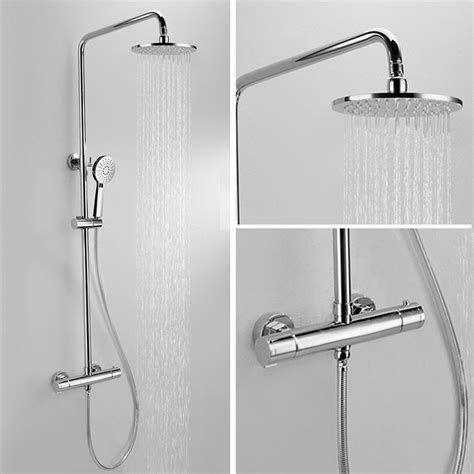I just visited some web galleries of bathroom remodelers in the US, and it looks uncommon to have external shower fixtures. They tend to bury as much of the fixture as possible in the wall. From the photos, I don’t get the impression they are using thermostatic mixing valves. But it’s hard to tell. Can anyone confirm or deny?
I think I might favor external fixtures because they tend to be much cheaper and also more easily servicable.
These days most usa bathroom fixture I’m familiar with have a single temperature control that you set and it keeps the temperature steady at the set temperature even if the water pressure varies. Is that what you are wondering about?
Yeah, kind of. I’m glad to hear they have that capability. But note that there are some non-thermostatic designs that come close to achieving the same effect. Those have a memory of sorts, where they know you want X volume of hot water and Y volume of cold water. Then if the pressure in one drops or increases, the valve will adjust the other line ensure the hot and cold have the same ratio regardless.
That’s pretty good. But it assumes the hot water and cold water are each at constant temps. So imagine if you get to near the end of a hot water tank supply, the hot water will gradually become colder. In that case, a thermostatic valve will open the hot even more to chase the temp you want. Whereas the pressure balance style will not. Perhaps more importantly, the pressure balance style does not counter the fact that the hot line will be initially cold since the hot water cooled down while sitting in the pipe. So you have to fiddle with readjustments until the hot pipe is maxed out.
What is a thermostatic mixing valve?
You have two controls, 1 for temp and one for pressure (instead of the traditional hot and cold with independent pressure controls on each). The temp knob has a stop in one position as you turn it, which gives 38°C water. The cheaper models are external and use a wax cylinder inside:

Wax expands as it gets warm. So when you first add pressure, internally the hot water valve is 100% open. Then as the water gets hotter at the valve, it closes and starts letting cold water in to retain the temp you select. It reacts quite fast too, so even if you have screaming hot water arrive at the fixture it’s quick enough to protect you from scalding. You set it and forget it. If someone else in the house flushes a toilet or runs a washer or dishwasher, thus causing the cold water to lose pressure, the thermostatic fixture will automatically adjust to maintain the temp.
The pricier ones are internal, which means all the complex valves are buried in the wall. And instead of wax they use a bi-metallic mechanism (which exploits the fact that a couple diferent metals bend differently with temp, or something like that). They look like this:

I think that has 2 pressure knobs, one for rainfall and one for the wand.
Whole external kits with rainfall and wand start at €100. If you just want the mixer bar and wand, it can be as cheap as €25. The internal kits start at around €500. I like the external ones not just because they are cheaper, but the plumbing is simple. You just need to have hot and cold threaded ½" pipes sticking out of the wall 15cm apart, which the fixture can screw onto.
Thanks for the detailed reply.
I’ve never heard of these before.
It’s a valve that controls both the pressure and temperature of the shower water. It maintains a constant temp through your shower.
But installing one is 2x the price of a normal pressure-balance valve.
Do you set it to the preferred temperature each time or is it just on/off to a pre-set temp?
There are two controls, one for pressure and one for temperature.
The most common one has a marker around 40°C then you can go hotter or colder.
https://www.hansgrohe.com/bath/products/showers/thermostatic-shower-valves
Cost is the limiter:
"Cons
By far, the biggest con to installing a thermostatic shower valve is the cost. These valves tend to be at least twice as expensive, if not many times more, as pressure-balance valves.
Another disadvantage is the trim that accompanies this type of valve because it has two handles. These can be trickier to install with simple plumbing upgrades because they use a wall-mounted plate behind the handles. They tend to come in contemporary designs, although it is possible to find models that work with more traditional bathroom decor."
The thermostatic mixers can get as cheap as €25. Though I think the cheap ones have a degree of slippage, whereby mid-shower I have to increase temp. I don’t know if that’s because it lost track of my setting, or if I adjusted to the temp physiologically and need hotter water to psychologically feel the same level of heat.
What kind of bothers me about the pressure balance design is you cannot tell from the pics if it’s really pressure balanced. I think the one handle style goes back decades, and originally did not maintain a balance. You have a joystick of sorts but if the pressure on one pipe changes you don’t know if it internally balances to maintain the ratio. So you have to read the product description and trust it.
I have not seen that in the US and didn’t know it existed, but I have not really looked anywhere other than the usual home Depot or Lowe’s, so I don’t know what new home designers are doing. We just installed an electronic version that has temp, volume, and wand vs overhead switch controls and presets on a wall mount thing. Of course it comes with an app, but we just use the controller on the wall. Maybe not as dependable as a mechanical control, but works fine so far.
Most controls I see in the US, like in houses and hotels, are all-in-one type things where you basically have to have max volume to get hot water. Usually inside the control you can set a max temp that limits the percent hot water in the mix. Some have separate volume and temp controls, but I don’t know if they’re doing anything fancy like you describe; and a few old homes have separate hot and cold knobs, but that’s rare.
Yeah, high end installations have been using them for years. You won’t find them in the big-box stores. I looked into all that when I redid my showers and decided to just go with Delta “Monitor” mixers. It worked pretty well with the old tank heater and it’s indistinguishable from a thermostatic now that I have an on-demand water heater. As a bonus, the Monitor valve is interchangeable with a regular mixer valve in case I’m broke when it fails and need to buy a cheap mixer valve.
I think the Monitor brand uses wax like you described in a comment but they don’t call them thermostatic, probably to differentiate them from their actual bimetal products.
Might be popular in new expensive builds
Standard house isn’t going to have them
Really I don’t see much of a point for one. Crappy house with crappy plumbing, but they aren’t going to buy a fancy valve to make the problems somewhat manageable.
Tankless water heaters are becoming more popular. The thermostatic valve would save you from turning the standard water mixer a little hotter when you run out of room temp cold water in the lines and the cold water from outside reaches the shower. Otherwise, you are always being supplied constant temperature water.
I feel like most people that would be willing to pay extra for a thermostatic valve would pay extra to have an oversized water heater, or even tankless.
It’s bizarre that thermostatic mixers are costly in the US. I can get a new one as cheap as €25 if I shop out the sales, or probably €10 2nd hand.
Tankless water heaters are really lagging as well in the US, and absurdly costly. I’m sure that will get corrected eventually. But in Europe tankless boilers are the norm and used in combination with thermostatic mixers. The lack of tank causes a delay in hot water because it’s less instant than a pre-heated tank. The heating element takes time to fire and reach a high temp. So you are even more tempted to open the hot valve 100% until the hot water comes, which means you have to diligently readjust the valve to avoid scalding.
The luxury fix to that delay is to have a 3rd pipe that cycles the (cold) hot water line to keep it hot in the pipes. This seems quite wasteful and complex so I wouldn’t want to install that.
Even a couple of dollars more for a contractor is a lot when a thermostatic valve doesn’t add any value.
You can get inexpensive tankless water heaters.
You want to open the hot valve 100% until the hot water comes because it conserves water. You want to clear out the hot water line as fast as possible. Turning it to 70% just takes longer to heat up and you’re just dumping cold water out for no reason.
You want to open the hot valve 100% until the hot water comes because it conserves water. You want to clear out the hot water line as fast as possible. Turning it to 70% just takes longer to heat up and you’re just dumping cold water out for no reason.
This is precisely what a thermostatic valve gives you. I don’t think you know how a thermostatic valve works. If the thermostat on the mixer bar is set at 38°C and you turn on the pressure control when the water in the hot line is cold, a thermostatic valve opens the hot 100% immediately and when the hot water arrives at the fixture it automatically adjusts. What you say about starting 70% open is exactly the problem you have when /not/ using a thermostatic valve, like the pressure balance valves that are common in the US.
(edit) also consider how tankless heaters have a minimum threshold for turning on. If you open the hot valve just a little, the heater will not be triggered. It must be open enough to trip the flow switch. It can be tricky to open the valve just enough to trigger the heat. A thermostatic mixer valve solves that.
Even a couple of dollars more for a contractor is a lot when a thermostatic valve doesn’t add any value.
I don’t think you saw the pic I posted of the cheap thermostatic mixer bar. Those can be installed by anyone because they are external. You just turn two union nuts until hand-tight then give ¾ turn extra with a wrench.


